 |

 |
 |
Marco Gubernamental, Jurídico y Regulador para la Seguridad
Colección de Normas de Seguridad del OIEA, 2010, 65 p.
The objective of this publication is to establish requirements in respect of the governmental, legal and regulatory framework for safety. It covers the essential aspects of the framework for establishing a regulatory body and taking other actions necessary to ensure the effective regulatory control of facilities and activities utilized for peaceful purposes. Other responsibilities and functions, such as liaison within the global safety regime and on support services for safety (including radiation protection), emergency preparedness and response, |
nuclear security, and the State system of accounting for and control of nuclear material, are also covered.
Contents: 1. Introduction; 2. Responsibilities and functions of the government; 3. The global safety regime; 4. Responsibilities and functions of the regulatory body.
Extraído de:
http://www-pub.iaea.org/MTCD/publications/PubDetails.asp?pubId=8608
|
 |
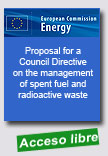 |
Proposal for a Council Directive on the management of spent fuel and radioactive waste
European Commission, November 3rd 2010, 23 p.
Member States are asked to present national programmes, indicating when, where and how they will construct and manage final repositories aimed at guaranteeing the highest safety standards. With the Directive internationally agreed safety standards become legally binding and enforceable in the European Union.
Radioactive waste is not only produced in those states that use |
nuclear for electricity generation, but also by many other applications, be it radiotherapies or industrial tests. Its safe management is therefore a challenge for all Member States, irrespective of their stance on nuclear.
While low and medium level radioactive waste is increasingly being taken care of, there is not yet a single final repository for high-level radioactive waste and spent fuel. It is likely, however, that the first such repositories will be opened between 2020 and 2025 in several EU Member States.
It is necessary that now all Member States deal with radioactive waste in a responsible and transparent manner and establish national frameworks and programs for the management of all types of radioactive waste and spent fuel. The generations benefiting from nuclear power and applications of radioactive materials should also take care of the waste and the financing thereof.
Extraído de:
http://ec.europa.eu/energy/nuclear/
waste_management/waste_management_en.htm
|
 |
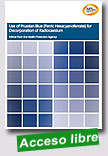 |
Use of Prussian Blue (Ferric Hexacyanoferrate) for Decorporation of Radiocaesium
Health Protection Agency (UK), December 2010, 94 p.
This document provides advice on the use of Prussian Blue (ferric hexacyanoferrate) as a decorporation agent in the event of poisoning with radiocaesium. It has been developed by the Health Protection Agency in partnership with a number of organisations using the scientific evidence available and advice from other countries.
The advice covers how radiocaesium contamination would be |
detected in the population and requirements for triage, dose assessment and monitoring, including timing and guidelines for the internal contamination levels at which treatment is advised. It also covers doses for adults and children, side-effects, duration of treatment and on-treatment monitoring. There is an appendix with draft public information leaflets for use in a contamination event, based on the proposed triage, monitoring and treatment guidelines.
Prussian Blue is a medical treatment, not suitable for mass distribution. The advice does not cover the logistics of arranging for prescription of this treatment in the NHS nor the use of Prussian Blue as an antidote for thallium poisoning.
Extraído de:
http://www.hpa.org.uk/Publications/Radiation/DocumentsOfTheHPA/
RCE17UseofPrussianBlue/
|
 |
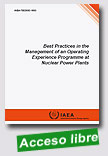 |
This publication has been developed to provide advice, assistance and good practices in the management of the OE programme to nuclear utilities, individual nuclear plants, regulatory organizations and other related institutes.
It is recognized that alternative means may exist and that organizations might effectively achieve this overall performance objective without meeting some or part of the specific criteria, attributes or practices described in the present publication.
|
Extraído de:
http://www-pub.iaea.org/MTCD/publications/PDF/te_1653_web.pdf
|
 |
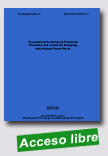 |
Occupational Radiological Protection Principles and Criteria for Designing New Nuclear Power Plants
Nuclear Energy Agency (NEA), 30 July 2010, 108 p.
Global demand for electricity continues to grow and numerous new nuclear power plants (NPPs) are being planned or constructed in NEA member countries. Most of these new NPPs will be of the third generation, and will be designed for as long as 80 years of operation. The successful design, construction and operation of these plants will depend broadly on appropriately implementing the lessons from experience accumulated to date.
|
This case study introduces a policy and technical framework that may be used when formulating technical assistance and guidance for senior managers of NPPs, designers, manufacturers, contractors and authorities responsible for regulating occupational radiation exposure. It is aimed in particular at assisting design and license assessments of new NPPs. Although not targeting the needs of countries introducing nuclear power for the first time, this case study can also provide valuable input on occupational radiological protection issues for the implementation of new nuclear energy programmes.
Extraído de:
http://www.nea.fr/pub/ret.cgi?id=new#6407
|
 |
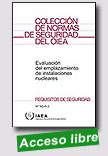 |
Evaluación del Emplazamiento de Instalaciones Nucleares
Colección de normas de seguridad, 2010, 43 p.
This Safety Requirements publication was prepared under the IAEA programme on Safety Standards for Nuclear Installations. It establishes requirements and provides criteria for ensuring safety in site evaluation for nuclear installations. The Safety Guides on site evaluation listed in the references provide recommendations on how to meet the requirements established in this Safety Requirements publication.
Contents: 1. Introduction; 2. General requirements; 3. Specific requirements for evaluation of external events; 4. Site characteristics and the potential effects of the nuclear installation in the region; 5. Monitoring of hazards; 6. Quality assurance; Glossary
|
Extraído de:
http://www-pub.iaea.org/MTCD/publications/PubDetails.asp?pubId=6965
|
 |
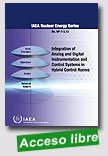
|
Integration of Analog and Digital Instrumentation and Control Systems in Hybrid Control Rooms
IAEA Nuclear Energy Series, 2010, 95 p.
The majority of instrumentation and control (I&C) equipment in nuclear power plants in the world was designed at least 30 to over 45 years ago with analog and relay components, and in some cases rudimentary digital technology. Today, most of these plants continue to operate with a substantial amount of this original I&C equipment that is or soon will be obsolete resulting in increasing maintenance efforts to sustain acceptable system performance. Decreasing availability of
|
replacement parts, and the accelerating deterioration of the infrastructure of manufacturers that support analog technology, accentuate the obsolescence problems and cause operation and maintenance (O&M) cost increases. License extension means that plants must be supported longer, which will increase obsolescence issues. In addition, older technology limits the possibilities for adding new beneficial capabilities to the plant systems and interfaces. New technology provides the opportunity to improve plant performance, human-system interfaces (HSI) functionality, and reliability; to enhance operator performance and reliability, and to address difficulties in finding young professionals with education and experience with older analog technology. Finally, there may be changes in regulatory requirements that could necessitate modernization activities.
Extraído de: http://www-pub.iaea.org/MTCD/publications/PDF/Pub1470_web.pdf
|
 |
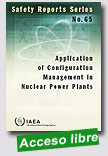 |
Application of Configuration Management in Nuclear Power Plants
IAEA Safety Reports Series, 2010, 114 p.
The purpose of this publication is to provide fundamental knowledge about configuration management, to provide information on its application and to offer guidance for selecting the proper approach to configuration management, and
establishing and maintaining an effective configuration management programme. This Safety Report highlights the safety aspects of configuration management and provides guidance on how to address issues related to this topic.
|
The publication is written primarily for operating organizations and technical support organizations (TSOs), but can also be used by regulatory bodies. This publication also provides advice and good practices to support development and improvement of an existing configuration management programme, or establishment of such a programme if none exists, and it is not
dependent on a particular organizational model. In addition, it may be used to facilitate training on the subject of configuration management.
Extraído de:
http://www-pub.iaea.org/MTCD/publications/PDF/Pub1461_web.pdf
|
 |
 |
Clausura de Instalaciones del Ciclo del Combustible Nuclear
OIEA Colección de normas de seguridad, 2010, 40 p.
El objetivo de esta Guía de Seguridad es proporcionar orientaciones a los órganos reguladores y las entidades explotadoras sobre la planificación y las medidas para una gestión segura de la clausura de las instalaciones sin reactores del ciclo del combustible nuclear. Aunque las consideraciones básicas de seguridad para la clausura de las instalaciones del ciclo del combustible nuclear son similares a las de las centrales nucleares, existen diferencias importantes, en particular en el diseño y los parámetros de funcionamiento de
|
las instalaciones, los tipos de material radiactivo y los sistemas de apoyo disponibles. El objetivo de esta Guía de Seguridad consiste en prestar asesoramiento para la parada y la clausura eventual de esas instalaciones, teniendo en cuenta sus características propias.
Extraído de: http://www-pub.iaea.org/MTCD/publications/PDF/Pub1110s_web.pdf
|
 |
|
|
|
|
|
|
|
|
|
|
|
